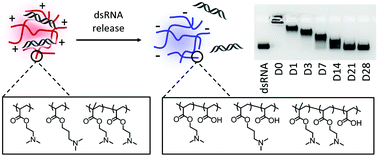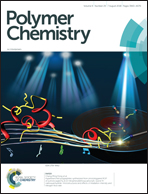Cationic and hydrolysable branched polymers by RAFT for complexation and controlled release of dsRNA†
Abstract
The controlled release of nucleic acids from cationic polymers is an important criteria for the design of gene delivery systems, and can be difficult to achieve due to the persistent positive charges required to initially complex the nucleic acids. Here, we report the use of highly branched tertiary amine-rich polymers for the complexation and release of dsRNA over a prolonged period of time. Controlled release of dsRNA is obtained via self-catalysed hydrolysis of the polymer side chains and associated change in electrostatic charge. Reversible addition–fragmentation chain transfer (RAFT) polymerization was utilised to synthesise a series of branched polymers of 2-(dimethylamino)ethyl acrylate (DMAEA), 3-(dimethylamino)propyl acrylate (DMAPA), and 2-(dimethylamino)ethyl methacrylate (DMAEMA) (MW ∼60 000–200 000 g mol−1) and copolymers thereof. The hydrolysis kinetics of all synthesised polymer materials were followed by 1H NMR spectroscopy. Complexation with dsRNA resulted in the formation of polyplex nanoparticles (N/P ratio of 5) with sizes of approximately 400 nm and surface charges of +15 mV. An agarose gel retardation assay showed sustained release of dsRNA from p(DMAEA-co-DMAEMA) for a period of more than 2 weeks. Unlike branched PEI commonly used for gene delivery, the majority of these systems showed little toxicity to cells (NIH3T3 fibroblasts). The results point towards pDMAPA and p(DMAEA-co-DMAEMA) being promising polymers for the controlled release of nucleic acids over prolonged periods.



 Please wait while we load your content...
Please wait while we load your content...